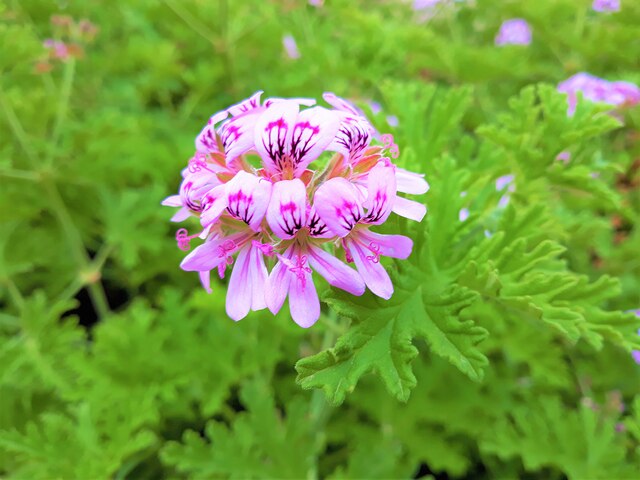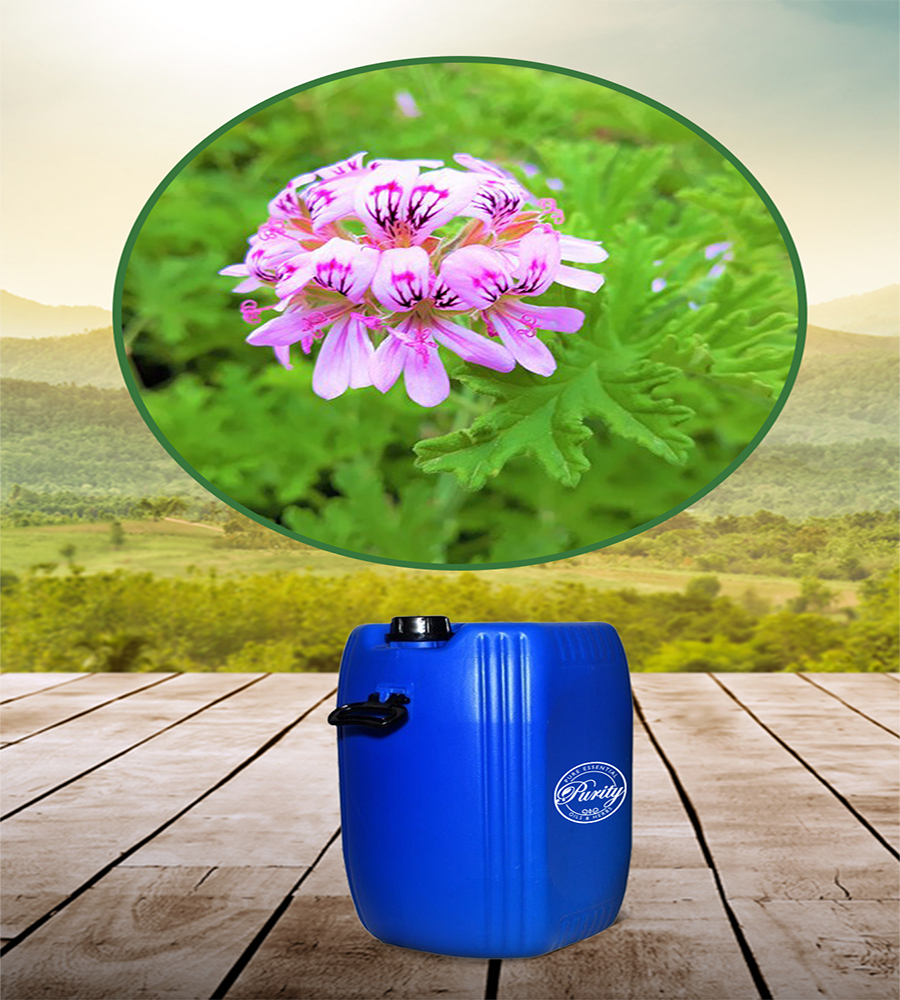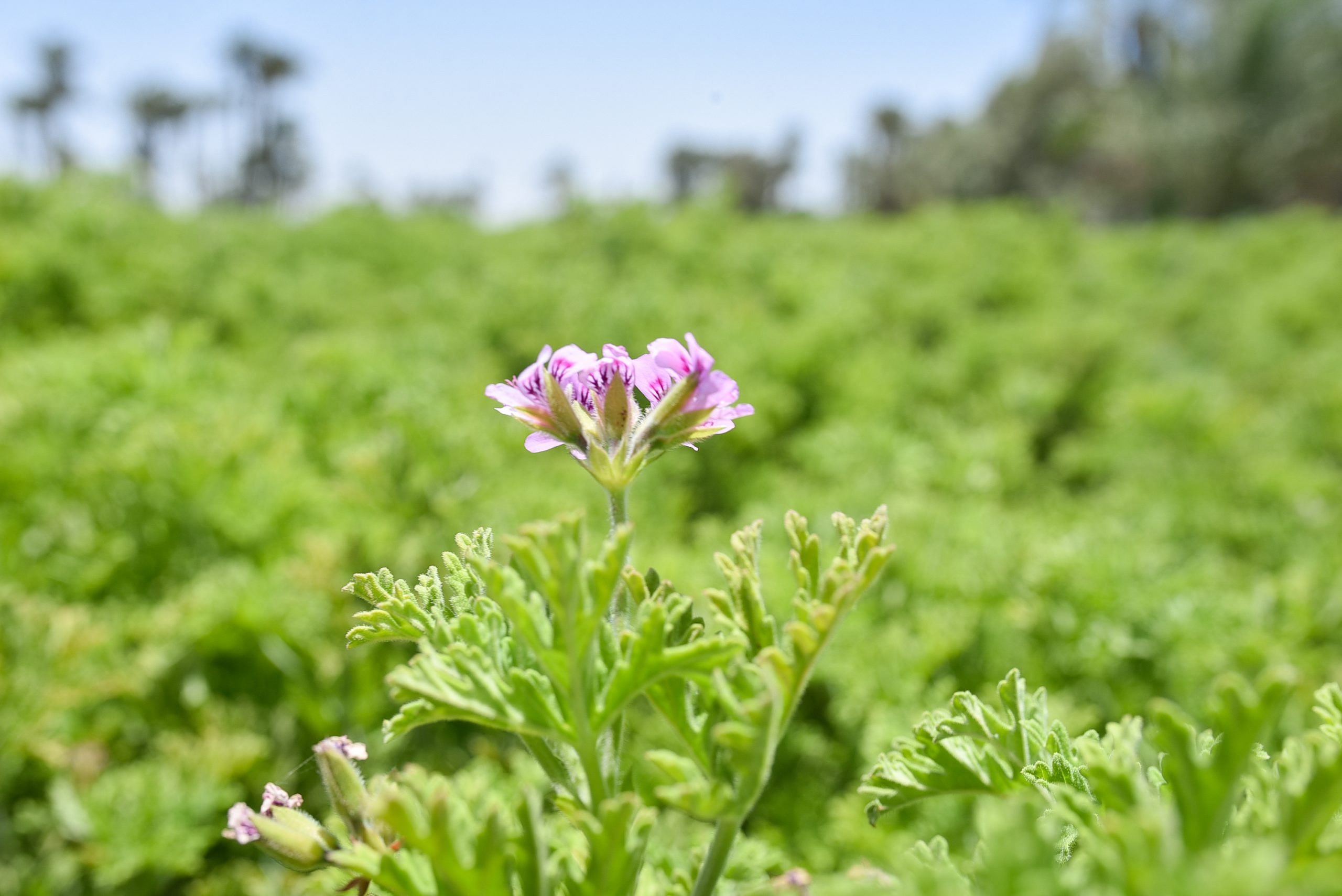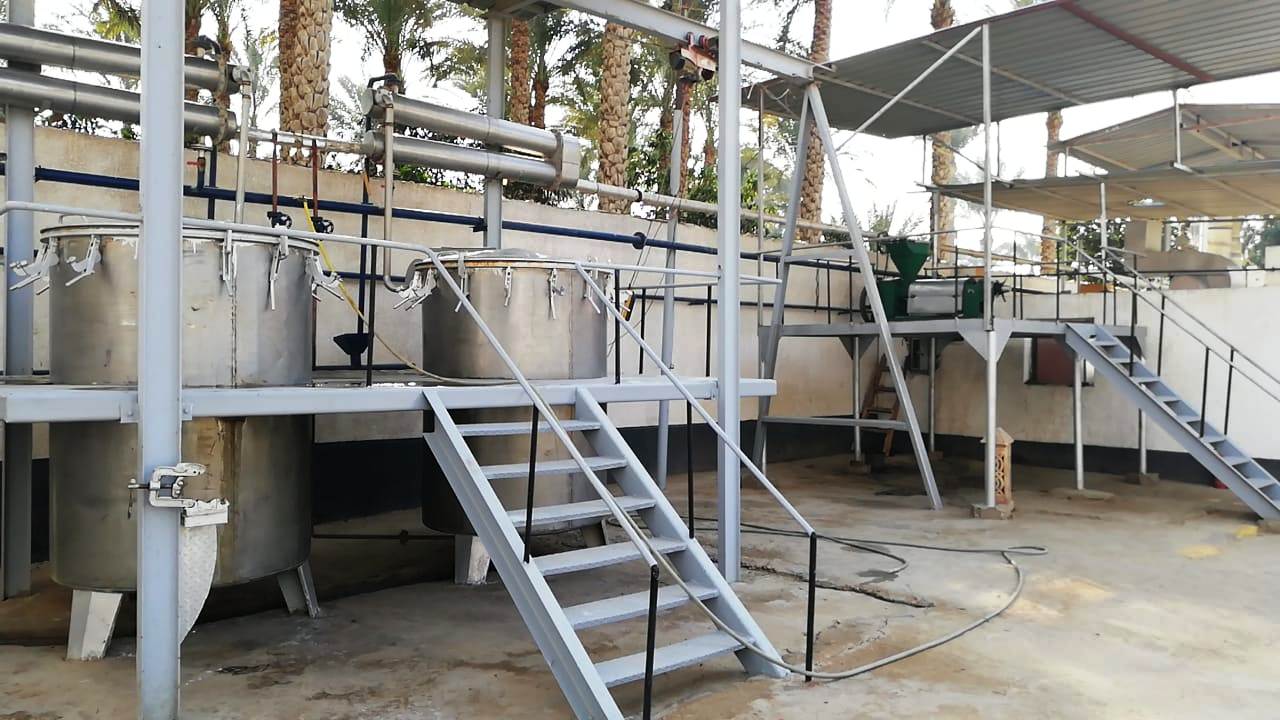Geranium Pelargonium graveolens Essential Oil
Login to view prices
Common name: Geranium
Latin name: Pelargonium graveolens L.
Family: Geraniaceae
Other names: Engl.: old fashion rose geranium, sweet scented geranium, lemon-scented geranium, rose geranium, rose-scent geranium. Deu.: Rosengeranie, Zitronen-Geranie. Suom.: palsamipelargoni
A lot of confusion exists today with the species Pelargonium, as to which variety applies to what origin. The classification of these species is made more difficult by the hybridization of garden species that leave us with numerous varieties. For example, Pelargomium graveolen, P. roseum, P. cpitatum, P. odoratissimu, P. fragrans, and P. terebinthinaceum have been stated as the source of Geranium oil.
Botanical Origin:
Common name: Geranium
Latin name: Pelargonium graveolens L.
Family: Geraniaceae
Other names: Engl.: old fashion rose geranium, sweet scented geranium, lemon-scented geranium, rose geranium, rose-scent geranium. Deu.: Rosengeranie, Zitronen-Geranie. Suom.: palsamipelargoni
A lot of confusion exists today with the species Pelargonium, as to which variety applies to what origin. The classification of these species is made more difficult by the hybridization of garden species that leave us with numerous varieties. For example, Pelargomium graveolen, P. roseum, P. cpitatum, P. odoratissimu, P. fragrans, and P. terebinthinaceum have been stated as the source of Geranium oil.
Description:
Pelargonium graveolens is an erect, much-branched shrub, that can reach a height of up to 1,3 m and a spread of 1 m. The hairy stems are herbaceous when young, becoming woody with age. The deeply incised leaves are velvety and soft to the touch due to the presence of numerous glandular hairs. The leaves are strongly rose-scented. The showy white to pinkish flowers are borne in an umbel-like inflorescence and are present from late winter to summer (August – January) peaking in spring (September – October).
The essential oil is contained in small glands, 1/15 to 1/18 mm. long, distributed over the green parts of the plant, particularly over the surface of the leaves. Many of these glands can be seen with the naked eye and impart to the surface a silvery satin-like shine.
Range & Habitat:
Rose geranium, Pelargonium graveolens L’Her. ex Ait., is one of the many fragrant species of Pelargonium used as a source of geranium oil. The woody, perennial herb is native to South Africa and is produced in Egypt, France, the People’s Republic of China, Algeria, South Africa, Morocco, and Spain.
In general, Pelargonium grows well in temperate, subtropical and tropical climates, and at a variety of altitudes. It thrives best in a subtropical (but not too warm) climate. Temperatures below +3º C kill the plant, for which reason it is grown as an annual in temperate countries, such as Southern France, and must be replanted each year. In warmer climates, Pelargonium becomes a perennial, lasting on the average from 5 to 6 years.
The plant requires a certain amount of moisture, either by rain, irrigation, or atmospheric humidity. This is why it flourishes in certain parts and altitudes of Reunion Island that are exposed to the moisture-laden monsoon winds.
The plant itself is quite resistant to drought, but may wither under conditions of excessive drought. After a long spell of dry weather the yield of oil diminishes greatly.
Pelargonium thrives well in porous, light soil which does not retain moisture in the winter or during the rainy season. A water-logged soil causes root-rot, and, in conjunction with excessive rain, may be as deadly to the plant as frost.
Also it was found that a calcareous light soil seems to produce more oil in the plant than a heavier clayey soil
Planting & Cultivation:
In Egypt Pelargonium is planted in two dates; the first is in the late October, and the second date is from the middle of February to the middle of March.
Since Pelargonium doesn’t produce seeds under the Egyptian environmental conditions, so the plant is only propagated by cutting in Egypt. About 20,000 to 25,000 cuttings are required /acre
Pelargonium is easily propagated by means of cuttings, which are prepared by terminal cuttings of strong stalks (not too woody, terminal cuttings gave 85 – 90 % success rate), about 25 cm long, each slip containing at least one eye.
The cuttings are prepared in September from a plant that was fasting from water for at least one month and planted immediately in shaded nurseries and watered, where they take root. For this purpose they should be placed into the furrows in a slanting position, the upper end protruding from the soil.
About two months later the young plants are transferred to the fields and planted 25 – 40 cm apart, in rows 80cm apart. The spacing depends upon the fertility of the soil and the amount of manure applied.
The soil should be plowed as deeply as possible, and dressed. After each harvest the field should hoed (or plowed) to remove all weeds
Fertilizers are, as a rule, not applied before the third or fourth year, preference being given to nitrogen-containing organic compounds. Inorganic (particularly acid) fertilizers should be avoided.
Harvesting and Preparing for the Market:
Immediately before or at the beginning of the flowering period, and preferably during dry weather, the plants are cut with pruning shears, care being taken to retain one shoot on each tuft.
On the average there are two harvests per year, the first harvest take place in April- June where the plants are in the beginning of the flowering period (50 % is blooming), when the originally lemon-like odor of the leaves has changed to a pronounced rose scent. However the second harvest takes place in September-October (for old plant and those planted at October) and at this stage the plant carries no flowers but the harvest is the color of the leaves changes to the straw yellow.
For Pelargonium planted in February, cuttings are taken only at August-September in the first year.
For distillation the overground parts of the plant, chiefly the leaves, are used, after the heavier stalk material has been removed in fact, in most producing regions the plant material is harvested in such a way that the woody parts are excluded, the cutting being done by hand and with short sickles, a very tedious and “back-breaking” task.
Method of Extraction:
By Steam Distillation Or Solvent extraction
Production of Gernaium oil:
Before distillation is started, 20 to 25 liters of water are poured into the still (550 to 650 liters). Then the plant charge is distilled for about ½ to ¾ of an hour, the length of distillation depending upon the steam pressure and the condition of the plant material.
According to Bourquelot and Bridel, the essential oil occurs in the glands partly as oil in free form and partly as β–geranyl glycoside. This may explain the fact that the yield of oil seems to be higher when the plants are permitted to dry and wither for a few hours (12 – 24 hrs), prior to distillation, as storage results in a slight fermentation (“curing”) and splitting of glycosides, which latter reaction supposedly increases the yield of oil.
Yield of oil:
It appears that the spring harvest (May-June) accounts for 2/3 of the total harvest, however the autumn harvest (September-October) accounts for only 1/3 of the total harvest.
The yield of 800 to 1000 kg of the fresh plant material is 1 kg oil in average.
Generally speaking, three factors influence the yield of oil:
- the weather (dry or wet).
- the soil (calcareous or clay).
- and the age of the plantation; the yield being increasing with increasing age till the third year, after that the yield is decreasing till it become non profitable at the seventh year.
The average yield of oil per acre is 20 to 25 kg (the sum of the two harvest of the year)
Production of Absolute and Concrete:
A portion of the geranium crop cultivated in the Grass region of Southern France, and in Morocco is not submitted to steam distillation, but to extraction with volatile solvents (chiefly benzene or petroleum ether).
500 kg of plant material yield about 1 kg of concrete of geranium, which on conversion, gives 600 to 700 gm of alcohol-soluble absolute.
- The concrete is a waxy, solid mass of dark green color, only partly soluble in high-proof alcohol.
- The absolute is liquid, of green color, soluble in high proof alcohol.
Both products possess a very fine, smooth, geranium odor, softer than that of the distilled oil, and much more lasting. However, in many preparations, the green color of the absolutes and concretes is considered objectionable; partly decolorized products of light brown color have, therefore, been developed and are available.
Concretes of geranium are to be recommended in preparations where solubility in alcohol is not required; the absolutes in products which demand solubility. Properly used, the concretes and absolutes give excellent results, imparting long lasting, smooth, geranium notes to soaps, perfumes, and cosmetics.
Geranium essential oil is derived by steam distillation of the leaves of Pelargonium graveolens, a plant species native to Egypt. According to folklore, it was used for a wide range of health conditions.
Geranium oil is grown in many regions, including Europe and Asia. There are many varieties and strains of the pink flower with a fresh, floral fragrance. Each variety differs in scent, but is near-identical in terms of composition, benefits, and uses.
Geranium oil is widely used as an ingredient in perfumes and cosmetics. The essential oil is also used in aromatherapy to treat a number of health conditions. In aromatherapy, essential oils are inhaled using a diffuser, or diluted with carrier oils and applied to the skin for soothing benefits.
Researchers have examined the benefits of geranium essential oil in several human and animal studies. There’s also anecdotal evidence about its benefits. It’s thought to have antioxidant, antibacterial, anti-inflammatory, antimicrobial, and astringent properties.
Phases of manufacturing the Geranium Oil:
Preparation of the Herbs:
- The herb are collected from our farms or from other authorized farms we supervise
- The herb are screened & the best are selected.
- The moisture level of the seeds is reduced to the optimum by a drying process.
Steam distillation Phase:
- The herbs are put in steam distiller.
- The oil gets collected into the Collection tank.
- The Oil is transferred to Drums from the collection tank and allowed to settle.
Filtration phase:
- The settled oil is then transferred to separate Drums and the oil is filtered mechanically passing through a Filter Press.
- The filtered Oil is collected into Iron Drums and Stored in air-tight condition
Export Markets:
We export our oils to many countries all over the world. USA, France, Germany, China, Malaysia, Algeria, Morocco, Indonesia…etc
Quotation:
- Incoterms: FOB Cairo Egypt
- Quantity: More than 200 L Minimum
- Specification: 100% natural and Pure quality
- Documentation: COA, MSDS, TDS, GC Peaks
- Packaging: Bulk in 180,60,25 liters Packs or retail packaging upon request
- Payment terms: TT in advance to Our bank account
- Lead time: Shipping through 10 days from receipt of the payment.
- Sea Shipping Time: 35 days
- Air shipping time: 10 days
Quality Certificates:
- ISO 9001-2015
- ISO 22000-2005
- GMP accredited by AQC Middle East FZE
- KOSHER Certificate
- Halal Certificate
- ORGANIC Certificate accredited by CERES GmbH Germany
- NOP Certificate accredited by CERES GmbH Germany
- Egyptian Ministry of Health Permission
Contact us please to receive other supporting documents for our Geranium Oil :
- COA
- MSDS
- TDS
- GC Peaks
Branding Services
We also can do customized packaging for you to bottle whatever size you like. We can help in designing labels, selecting good bottles, and packaging. We deliver integrated solutions under your brand..
Organically Certified Oil Available upon request
Additional information
| Weight | N/A |
|---|---|
| Dimensions | N/A |
| Oil Purity | 100% Natural & Pure without any chemical, flavor, food additive or carrier. |
| Ship from | Egypt |
| Country of Origin | Egypt |
| Cultivation Type | Organic Certified, Organic not Certified, Conventional |
| Oil Bulk Packaging | 180 kg Steel Drum, 25 kg HDPE Plastic Jerrycan, 50 kg HDPE Plastic drum |
| HS Code | 33012990 |
| CAS Number | 8000-46-2 |
| Oil Documentation Available | Allergen Free Certificate, Bovine Spongiform Encephalophathy (BSE) Certificate, Certificate of Analysis (COA), GMO Certificate, GRAS Status Statement, Halal Certificate, Herbal Origin Statement, KOSHER Certificate, Manufacturing Flow Chart, Material Safety Data Sheet (MSDS), Organic Certificate, Pesticide Residual Certificate, Researches & Studies, Technical Data Sheet (TDS), WADA Prohibited list Statement |
-
Login to view prices
Jasmine Infused Oil (Natural Jasmine oil or flowers infused in Carrier Oil)
Login to view prices Read more -
Login to view prices
-
Login to view prices
-
Login to view prices











